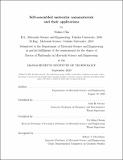Self-assembled molecular nanomaterials and their applications
Author(s)
Cho, Yukio
DownloadThesis PDF (22.07Mb)
Advisor
Ortony, Julia H.
Chiang, Yet-Ming
Terms of use
Metadata
Show full item recordAbstract
Self-assembly of small molecules in water provides a bottom-up strategy to generate highly ordered nanostructures with dimensions on molecular (<10 nm) length scales. However, molecular self-assembled nanomaterials have traditionally been employed mostly in biological applications due to two critical and inherent constraints: 1) The nanostructures lack cohesive interactions for stability outside of an aqueous environment, and 2) Modifying their functionality, often attributes to the surface chemistry of nanostructures, without disturbing molecular packing is challenging. This dissertation explores a new self-assembling platform called “aramid amphiphiles (AAs)”. These AAs incorporate hallmark features of Kevlar, the renowned material used in bulletproof vests, to enhance cohesive intermolecular interaction and suppress dynamic motion of constituent molecules. In this study, a spontaneous self-assembly of AAs with various functionalities into one dimensional, high-aspect-ratio AA nanomaterials in water has been observed. These nanomaterials not only exhibit remarkable mechanical strength but also maintain stability outside of an aqueous environment, where the initial driving force of self-assembly is typically absent. Leveraging their mechanical robustness and high aspect-ratios morphologies, these individual nanomaterials can undergo shear alignment to form hierarchically ordered macroscopic material that is mechanically flexible and stable in air. Furthermore, the enhanced intermolecular cohesion also provides an alternative pathway to circumvent the previously mentioned second constraint. This is accomplished through the use of domain-selective thermal decomposition, a process that strategically removes the thermally labile hydrophilic domains while maintaining the thermally stable internal cohesive domain of AA nanomaterials.
This dissertation also broadens the potential applications of AA nanomaterials by tailoring the surface chemistry functionality of constituent AAs. For example, the AA nanomaterials can be modified to dissociate lithium salt and exhibit lithium-ion conductivity by incorporating an oligomer form of polyethylene oxide. The resulting AA solid-state membrane, composed of molecular self-assembled nanomaterial, enables a unique feature of reversibility. This feature facilitates easier separation of different components, thus enhancing battery recycling - a technology that is currently economically impractical and technically challenging. Moreover, the AAs can be tailored to self-assemble into high-aspect-ratio, rigid nanotubes with the surface functionality to immobilize metal nanoparticles. The sub-nm diameter metal nanoparticles are highly catalytically active, but they are often not cost-effective to separate from solution due to their size. Assembling these metal nanoparticles onto the AA nanotubes not only maintain the high surface- volume ratio necessary for effective catalysis, but also enables the assemblies to be separated from the solution and reused through a simple filtration process. This dissertation thereby paves the way for using molecular self-assembly to create advanced, nanostructured, solid-state molecular materials.
Date issued
2023-09Department
Massachusetts Institute of Technology. Department of Materials Science and EngineeringPublisher
Massachusetts Institute of Technology